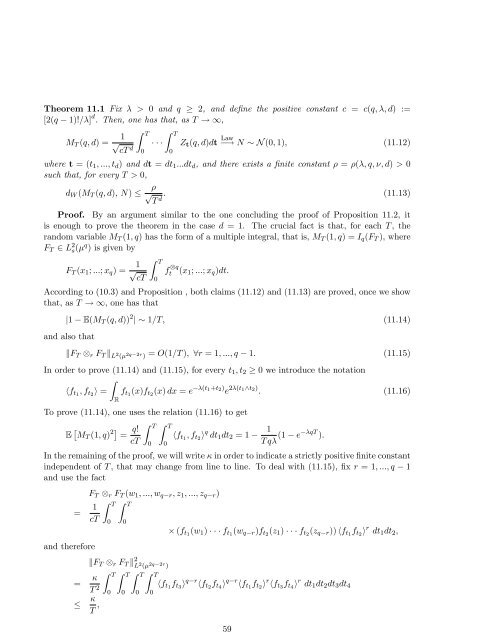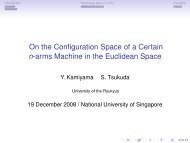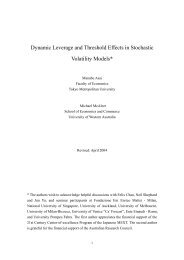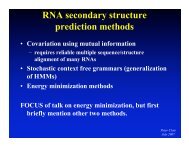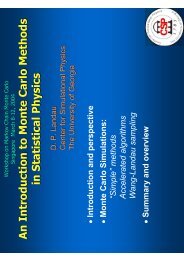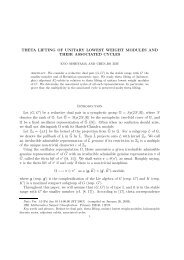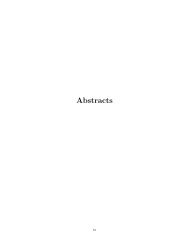Stein's method, Malliavin calculus and infinite-dimensional Gaussian
Stein's method, Malliavin calculus and infinite-dimensional Gaussian
Stein's method, Malliavin calculus and infinite-dimensional Gaussian
You also want an ePaper? Increase the reach of your titles
YUMPU automatically turns print PDFs into web optimized ePapers that Google loves.
Theorem 11.1 Fix > 0 <strong>and</strong> q 2, <strong>and</strong> de…ne the positive constant c = c(q; ; d) :=<br />
[2(q 1)!=] d . Then, one has that, as T ! 1,<br />
M T (q; d) = 1 p<br />
cT d<br />
Z T<br />
0<br />
<br />
Z T<br />
0<br />
Z t (q; d)dt Law ! N N (0; 1); (11.12)<br />
where t = (t 1 ; :::; t d ) <strong>and</strong> dt = dt 1 :::dt d , <strong>and</strong> there exists a …nite constant = (; q; ; d) > 0<br />
such that, for every T > 0,<br />
d W (M T (q; d); N) p : (11.13)<br />
T d<br />
Proof. By an argument similar to the one concluding the proof of Proposition 11.2, it<br />
is enough to prove the theorem in the case d = 1. The crucial fact is that, for each T , the<br />
r<strong>and</strong>om variable M T (1; q) has the form of a multiple integral, that is, M T (1; q) = I q (F T ), where<br />
F T 2 L 2 s( q ) is given by<br />
F T (x 1 ; :::; x q ) = 1 p<br />
cT<br />
Z T<br />
0<br />
f q<br />
t (x 1 ; :::; x q )dt:<br />
According to (10.3) <strong>and</strong> Proposition , both claims (11.12) <strong>and</strong> (11.13) are proved, once we show<br />
that, as T ! 1, one has that<br />
j1 E(M T (q; d)) 2 j 1=T; (11.14)<br />
<strong>and</strong> also that<br />
kF T r F T k L 2 ( 2q 2r ) = O(1=T ); 8r = 1; :::; q 1: (11.15)<br />
In order to prove (11.14) <strong>and</strong> (11.15), for every t 1 ; t 2 0 we introduce the notation<br />
Z<br />
hf t1 ; f t2 i = f t1 (x)f t2 (x) dx = e (t 1+t 2 ) e 2(t 1^t 2 ) : (11.16)<br />
R<br />
To prove (11.14), one uses the relation (11.16) to get<br />
E M T (1; q) 2 = q!<br />
cT<br />
Z T Z T<br />
0<br />
0<br />
hf t1 ; f t2 i q dt 1 dt 2 = 1<br />
1<br />
T q (1 e qT ):<br />
In the remaining of the proof, we will write in order to indicate a strictly positive …nite constant<br />
independent of T , that may change from line to line. To deal with (11.15), …x r = 1; :::; q 1<br />
<strong>and</strong> use the fact<br />
= 1<br />
cT<br />
<strong>and</strong> therefore<br />
F T r F T (w 1 ; :::; w q r ; z 1 ; :::; z q r )<br />
Z T Z T<br />
0<br />
0<br />
kF T r F T k 2 L 2 ( 2q 2r )<br />
= T 2 Z T<br />
0<br />
Z T Z T Z T<br />
0<br />
0<br />
0<br />
(f t1 (w 1 ) f t1 (w q r )f t2 (z 1 ) f t2 (z q r )) hf t1 f t2 i r dt 1 dt 2 ;<br />
hf t1 f t3 i q r hf t2 f t4 i q r hf t1 f t2 i r hf t3 f t4 i r dt 1 dt 2 dt 3 dt 4<br />
T ; 59


